Lower Bergamo is often synonymous with a modern, fast city, and part of it really sports that "futurist" attitude to life; but, just like a prism, it has many other facets to show you.
Join us on this itinerary through its post-20th century neighbourhoods, shopping streets, rush hour crossroads and Renaissance villages - almost a city within a city - with their theatres and majestic buildings suspended between the 17th century and Neoclassicism. A day of leisure awaits you, midway between an easy walk, a cultural and a poetic one.
Lower Bergamo is often synonymous with a modern, fast city, and part of it really sports that "futurist" attitude to life; but, just like a prism, it has many other facets to show you.
Join us on this itinerary through its post-20th century neighbourhoods, shopping streets, rush hour crossroads and Renaissance villages - almost a city within a city - with their theatres and majestic buildings suspended between the 17th century and Neoclassicism. A day of leisure awaits you, midway between an easy walk, a cultural and a poetic one.
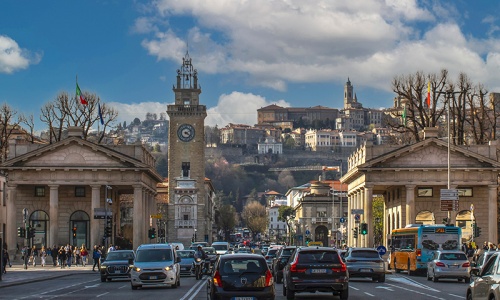
The starting point is the crossroads of Bergamo par excellence: Largo di Porta Nuova. Here you start with an exceptional view, the Upper Town framed by the Propylaea, the two small temples that mark what was the main entrance to the walls in medieval times.
From here continue along Viale Papa Giovanni XXIII, past the Monument to the Partisan, and reach the Sentierone. This tree-lined avenue is the Bergamo promenade par excellence; take it and, shortly after, on your right you can admire the Donizetti Theatre, built at the end of the 18th century and dedicated to the composer of the same name, one of the most representative figures of the city.
At the end of the avenue you will find the sixteenth-century Church of Saints Bartolomeo and Stefano, which preserves the magnificent Martinengo altarpiece, the largest painting made by Lorenzo Lotto.
To the right of the church begins Via Tasso, one of Bergamo’s historic streets, originally inhabited by the Waldensian community who had moved here for trade from Switzerland. Follow it all the way and, at the crossroads with Via Pignolo, there is a second famous place of worship: the very special Church of Santo Spirito, which preserves another masterpiece by Lotto.
POI
The starting point is the crossroads of Bergamo par excellence: Largo di Porta Nuova. Here you start with an exceptional view, the Upper Town framed by the Propylaea, the two small temples that mark what was the main entrance to the walls in medieval times.
From here continue along Viale Papa Giovanni XXIII, past the Monument to the Partisan, and reach the Sentierone. This tree-lined avenue is the Bergamo promenade par excellence; take it and, shortly after, on your right you can admire the Donizetti Theatre, built at the end of the 18th century and dedicated to the composer of the same name, one of the most representative figures of the city.
At the end of the avenue you will find the sixteenth-century Church of Saints Bartolomeo and Stefano, which preserves the magnificent Martinengo altarpiece, the largest painting made by Lorenzo Lotto.
To the right of the church begins Via Tasso, one of Bergamo’s historic streets, originally inhabited by the Waldensian community who had moved here for trade from Switzerland. Follow it all the way and, at the crossroads with Via Pignolo, there is a second famous place of worship: the very special Church of Santo Spirito, which preserves another masterpiece by Lotto.
POI
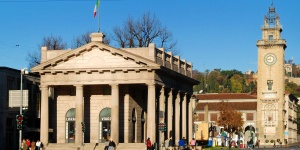
Train is the best way to get to Bergamo: going out of the railway station, you have an immediate and wonderful overview of the city. Your sight follows a straight line going up to Porta Nuova, the heart of the Lower Town. Raise your head just a little bit and your eyes will be filled with the majestic and perfect landscape of the Upper Town.
In 1837, the old wicket gate nestled in the “Muraine”, the massive XV Century walls that used to surround the hills and go down to the Lower Town and the old districts, was replaced by an iron gate opening a breach in the defensive walls: it is Porta Nuova (“New Gate”).
This place represented the main gateway to the commercial area of Bergamo for a very long time. Today, it is still the main junction around which the main streets and monuments of the Lower Town lie.
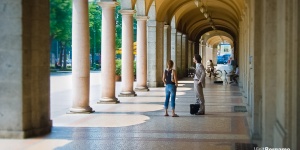
The centre of modern Bergamo is the ideal place to walk in the name of shopping, amusement, art and history!
This ancient and elegant part of the city is called Centro Piacentiniano, an amazing architectural complex that used to host the old city trade fair. This very same atmosphere still enlivens the area, thanks to the numerous markets and events filling the city centre with colours and scents all over the year. Walking along the Sentierone pedestrian way, passing by the imposing chestnut trees and beyond the Porta Nuova propylaea, you will get to via XX Settembre: here you can admire Palazzo Frizzoni, Bergamo’s City Hall.
From here on, enjoy the local life: boutiques, shops, alleys and beautiful small squares, in the name of amusement. Last but not least, how about a good coffee or a drink in one of the numerous cafes and bars?
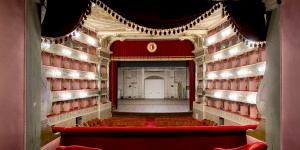
The Teatro Donizetti covers a total area of 3200 square meters. The hall’s dimensions respect the original 1786 design: it measures 360 square meters and it’s able to seat 532 people. There are 120 boxes, divided into three tiers, totalling 1154 seats.
It’s easy to understand how magnificent this building is and how astonished the Bergamo citizens were as they saw it, in an age when there only were small and temporary wooden theatres.
An enormous and sparkling chandelier, with 78 lamps, hangs from the middle of the ceiling, while other sources light up the stage.
Due to its sound harmony and distribution, the theatre is considered one of the best ones in Italy.
Originally named “Riccardi” after its maker, this Theatre is mostly renown as the place where Donizetti’s operas (more than 70!) were spread and appreciated by his fellow citizens.
Try to imagine the emotion experienced by Donizetti in theatre, when the audience assisting to the opera “L’esule di Roma – The exile from Rome”, gave a sincere and warm ovation. This happened in 1840: Donizetti would eventually die of disease in Bergamo a few years later, in his hometown, in 1848.
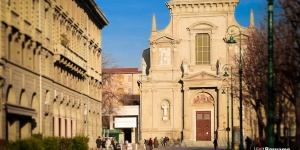
At the end of the eastern end of the Sentierone promenade, you can see the Church of Saints Bartolomeo and Stefano, built for the Dominican Religious Order in the first half of XVII Century, following the plan of the architect Antonio Maria Caneva.
Dominican order was not the first one to live in these places: in fact, the site used to belong to the community of the Order of the Humiliati. Formerly the complex used to consist of a church and some farmhouses.
If you observe the church from the outside you can notice the different construction periods: the façade, imitating a baroque style, was rebuilt in 897, the portico on the left was renovated in 1942, while the side overlooking via Tasso was made during the XIX Century.
The church features one aisle with five chapels on each side. The choir is decorated with beautiful XVI Century inlays, while behind the main altar you can admire the renowned Martinengo Altarpiece by Lorenzo Lotto, dating back to 1516.
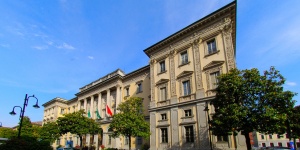
Following Italian Unification, marked the transfer of political power from the Upper Town to the Lower Town. Designed by Pier Antonio Preda, the bas-reliefs on the facade are by Pagani, Ceruti and Maironi, while frescoes of mythological subjects by Giovan Battista Castello can be seen inside.
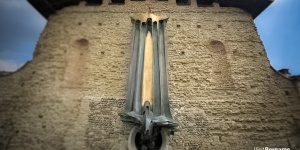
Walking along via Tasso, in the centre of Lower Bergamo, you will surely notice the rough façade of this church, overtopped by the imposing bronze statue of the Holy Ghost descending to the churchyard.
The previous building belonged to a XIV Century monastery. A group of rich merchants in the XVI Century decided to radically transform it in order to establish its social status by means of a church, besides the numerous palaces.
The church renovation took a long time. Over different periods, the two major architects from Bergamo worked on it: Pietro Isabello in the XVI Century and Gian Battista Caniana in the XVIII Century.
Five chapels per side flank the central nave. The fourth one on the right hosts the wonderful Altarpiece (oil on table) by the Italian Renaissance master Lorenzo Lotto, "Madonna and Child with Saint Catherine of Alexandria, St. Augustine, St. Sebastian and St. Anthony Abbot", 1521.
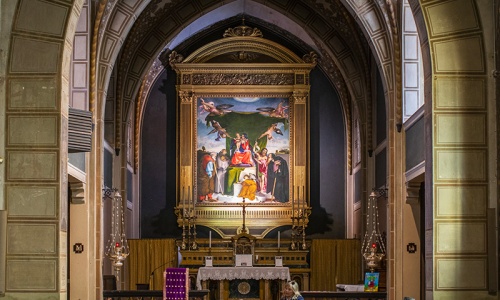
Via Pignolo is the heart of the multifaceted Pignolo Neighbourhood, where past and present coexist harmoniously between stately homes and craft workshops. Leave Santo Spirito behind you and go up the street to the crossroads with Via Verdi. Here, on the other side of the street, another exceptional church awaits you, S. Bernardino, with a single hall and a neo-Gothic appearance with an impressive altarpiece by Lotto that dominates the altar.
Keep going up Via Pignolo and you will soon come across one of the most prestigious locations in the city, Palazzo Agliardi, still inhabited today by the Conti Agliardi family.
Almost opposite, is one of the three churches dedicated to the patron saint of Bergamo, S. Alessandro in Croce, which is definitely worth a visit. A little further on you will find the sculptural fountain called "del Delfino", a short detour to see one of the most picturesque squares in the city.
POI
Via Pignolo is the heart of the multifaceted Pignolo Neighbourhood, where past and present coexist harmoniously between stately homes and craft workshops. Leave Santo Spirito behind you and go up the street to the crossroads with Via Verdi. Here, on the other side of the street, another exceptional church awaits you, S. Bernardino, with a single hall and a neo-Gothic appearance with an impressive altarpiece by Lotto that dominates the altar.
Keep going up Via Pignolo and you will soon come across one of the most prestigious locations in the city, Palazzo Agliardi, still inhabited today by the Conti Agliardi family.
Almost opposite, is one of the three churches dedicated to the patron saint of Bergamo, S. Alessandro in Croce, which is definitely worth a visit. A little further on you will find the sculptural fountain called "del Delfino", a short detour to see one of the most picturesque squares in the city.
POI
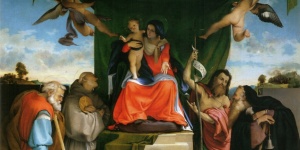
Situated at the entrance of Bergamo’s most aristocratic road, this church was most likely built following the saint’s two visits to the city (1419-1422). Re-consecrated by the bishop in 1593, perhaps after a major restoration, it was decorated throughout the years.
Its neo-Gothic form was created between the nineteenth and twentieth century: a single space, punctuated by 5 bays, 3 of which are believed to be fifteenth-century, with a gabled facade. The altarpiece is the work of Lorenzo Lotto (1521) .
The church is managed by the Parish of Sant'Alessandro in Croce, and the visit is free thanks to the collaboration of the Touring Club Italiano volunteers.
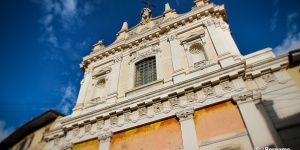
As you walk along via Pignolo, the medieval street connecting the Lower City with the “Città Alta”, you will get to a small square: the church of Sant’Alessandro della Croce is located right there. According to the legend, it was originally built during the time of Alessandro’s martyrdom, in IV Century. However, its interiors were rebuilt between XVII and XVIII Century, while the façade was only completed in 1922.
It is called “della Croce – of the Cross” because it was built at the crossroad among four medieval boroughs.
The Church is decorated with some of the most beautiful paintings in Bergamo. We just mention two masterpieces by Gian Battista Moroni: “Coronation of the Virgin”, located on the counter façade, and Crucifixion with Saint Sebastian, John the Baptist and a devotee” in the sacristies.
There are three chapels on each side of the nave: in the first one you will find an empty urn, which used to be the tomb of Saint Alessandro, whose remains are currently kept in the Cathedral of Bergamo.
On the other side, the second chapel on the right holds a beautiful altar made exclusively of precious multi-coloured marbles, carried out by the master Andrea Fantoni in 1729:a unique work for that time, demonstrating his amazing skills.
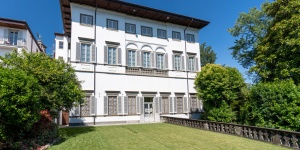
The palace, originally called Martinengo Colleoni, is located in the ancient suburb of Pignolo, where already in the 1500's important families of noblemen and merchants decided to have their houses built.
A large courtyard gives admission to bright rooms, decorated with frescoes of the 1700's by Carlo Innocenzo Carloni and Federico Ferrario. The lively decorations in the rooms are delightful and the pensile garden they look on to is wonderful.
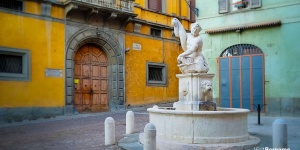
Let’s dive into the deep waters of Lower Bergamo: how is it possible?
Thanks to the beautiful Dolphin Fountain. A strong two-tales triton rides a dolphin by which the water gushes, along with the two deity masks on the column sides.
You will better appreciate the fluid lines of this Fountain by walking around it, admiring the triton’s dynamic pose.
On the other hand, there is also a bas-relief on the Fountain’s base representing a big pinecone, the symbol of the Pignolo borough, one of the most ancient districts of Bergamo.
In the Middle Age, before the Venetian Walls were built, this area was full of wide and lush conifer woods, whose fruit is indeed the pinecone.
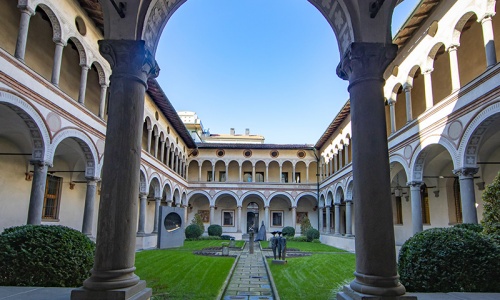
Go back in the direction you came from for a short distance and walk along Via Masone for a real journey through time, from historic churches to the Institute of the Ursuline Sisters of Gandino, up to a return to modernity. At the end of the descent, the twentieth-century Post Office Building awaits you, inaugurated in 1932 to a design by Mazzoni.
Turn left and walk along Via Locatelli to the crossroads with Via Monte Grappa: from here you have panoramic access to Piazza Dante, part of the large Piacentinian Centre designed in the 1920s by architect Marcello Piacentini. In the underground space, you will also find the ex-Diurno, once an air-raid shelter and now, as already in the post-war period, a meeting place thanks to the various surrounding businesses.
The itinerary continues in the other half of the Centre: take the exit opposite Via Monte Grappa, cross the road and you will immediately find the Memorial Tower, followed by the beautiful Cloister of Santa Marta. A little further on stands Palazzo Frizzoni, once belonging to one of the richest Protestant families in Bergamo, and today the town hall.
POI
Go back in the direction you came from for a short distance and walk along Via Masone for a real journey through time, from historic churches to the Institute of the Ursuline Sisters of Gandino, up to a return to modernity. At the end of the descent, the twentieth-century Post Office Building awaits you, inaugurated in 1932 to a design by Mazzoni.
Turn left and walk along Via Locatelli to the crossroads with Via Monte Grappa: from here you have panoramic access to Piazza Dante, part of the large Piacentinian Centre designed in the 1920s by architect Marcello Piacentini. In the underground space, you will also find the ex-Diurno, once an air-raid shelter and now, as already in the post-war period, a meeting place thanks to the various surrounding businesses.
The itinerary continues in the other half of the Centre: take the exit opposite Via Monte Grappa, cross the road and you will immediately find the Memorial Tower, followed by the beautiful Cloister of Santa Marta. A little further on stands Palazzo Frizzoni, once belonging to one of the richest Protestant families in Bergamo, and today the town hall.
POI
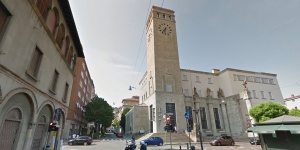
Blown glass lamps, marble floors, elegant furniture and wooden portals adorned with precious materials such as alabaster: the Post Office Building is surely one of the most outstanding architectural complexes in Bergamo.
The building is an amazing example of early XX Century vanguard architecture and was designed within an urban renewal project aimed to modernize this part of the city. Thanks to its massive size the Post Office Building can be seen even from a distance, so if you’re strolling along the Sentierone you can just turn and go admire it!
The statues decorating the external fountain, a beautiful basin adorned with mosaic tiles, will enchant you.
Last but not least, the Post Office Tower can be spotted even in the night from every part of the city, thanks to the red lights of the clock hands.
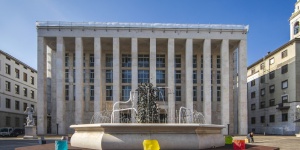
Once known as Casa Littoria, dedicated to city hero Antonio Locatelli and the highly symbolic headquarters of the local Fascist Party, the Palazzo della Libertà is located in the heart of Lower Town.
It serves as a scenic and monumental backdrop to the square of the same name, created during the redevelopment plan of the area where the old Ospedale S. Marco stood, demolished in the 1930s.
In 1936, in order to better redefine this empty space, a competition was announced: the judging committee - which included Marcello Piacentini, author of the magnificent Piacentiniano Center - decided to award first prize to the design by architect Alziro Bergonzo. The square was opened to citizens on October 28, 1939, the anniversary of the March on Rome, with the hope that Mussolini would officially inaugurate it the following year, which did not happen.
It became property of the State Property Office after the war, became the Casa della Libertà and was used as the headquarters of various bodies and associations, with considerable internal transformations.
Since 2017, the City of Bergamo has held permits for the use of space on the ground floor.
The architectural body is completely covered in white-pink marble from Zandobbio. The main facade, located on Piazza Libertà, consists of an imposing portico of twelve pillars of massive order; the dedication "To Antonio Locatelli, three times gold medalist, hero of the War and Revolution" stands out on the architrave.
The main entrance staircase is decorated with six bas-reliefs by Edoardo Villa, depicting various protagonists of Bergamo history. The staircase leads to the monumental atrium, originally illuminated by stained-glass windows and a skylight; on the wall separating it from the former Salone della vecchia guardia ("Hall of the Old Guard" now an auditorium), you can admire the Vita eroica di Antonio Locatelli ("Heroic Life of Antonio Locatelli"), created by Antonio Giuseppe Santagata in 1940. In addition to the hall, the ground floor originally housed the shrine, administrative and technical offices. The second floor housed the offices of the Federale and those of the Political Secretariat; the upper floors housed the offices of some party organizations.
Among the building's special features is the fact that Alziro Bergonzo designed not only the architectural part, but also the office furnishings, the intended use of which was already foreseen in the competition announcement.
Among the artists who worked on the decorative apparatus are the names of Leone Lodi (1900-1974), Nino Galizzi (1891-1975) and the aforementioned Edoardo Villa (1915-2011) for the sculptures, Contardo Barbieri (1900-1966), Arnaldo Carpanetti (1898-1969), Gianfilippo Usellini (1903-1971) and Domenico Rossi (1911-1955) for the paintings.
The building has a close spatial and decorative relationship with the square in front. Right in front, at the center of the geometric partition that ideally connects all the surrounding buildings, dominates the octagonal fountain by Claudio Nani, whose body dialogues with the shapes and colors of the building. Moreover, on the left side is Elia Ajolfi's big statue, I doni della terra (The Gifts of the earth)(1999).
The building is one of the most important twentieth-century works built in Bergamo.
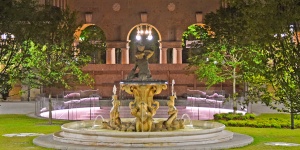
A key space in the city centre, Piazza Dante opens behind Sentierone’s quadriportico and houses on its sides the Palazzo della Procura and the Chamber of Commerce building.
In 1700, for a project by Giovan Battista Caniana, it housed the historic Sant'Alessandro fair with its 540 shops. In the 1920s it was redeveloped by Piacentini, who designed the entire complex of the Sentierone together with the other two central squares Vittorio Veneto and Matteotti. At its centre today stands a Zandobbio marble fountain depicting Neptune surrounded by tritons and sea horses.
Below Piazza Dante, which has undergone a very recent restoration, its underground counterpart develops. Not everyone knows that an air-raid shelter was built under the flooring which, at the end of the Second World War, was converted into a day hotel: about 1200 square metres of covered space with a large central dome, a social space where one took care of oneself. There you could find public toilets, a barber, a shoemaker, a bookshop, a bar and a large hall where they played billiards.
The day hotel has been closed for about forty years, from 1978 until today, when it was redeveloped together with the square. It will soon be re-inaugurated and will host entertainment activities, shows and venues that will deal with restauration, offering from breakfast to after dinner.

The centre of modern Bergamo is the ideal place to walk in the name of shopping, amusement, art and history!
This ancient and elegant part of the city is called Centro Piacentiniano, an amazing architectural complex that used to host the old city trade fair. This very same atmosphere still enlivens the area, thanks to the numerous markets and events filling the city centre with colours and scents all over the year. Walking along the Sentierone pedestrian way, passing by the imposing chestnut trees and beyond the Porta Nuova propylaea, you will get to via XX Settembre: here you can admire Palazzo Frizzoni, Bergamo’s City Hall.
From here on, enjoy the local life: boutiques, shops, alleys and beautiful small squares, in the name of amusement. Last but not least, how about a good coffee or a drink in one of the numerous cafes and bars?
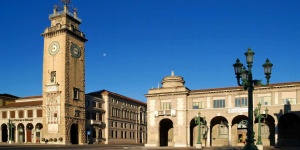
Beyond the propylaea in Porta Nuova, in the heart of the lower city, stands the monument dedicated to the memory of those who died during the Great War.
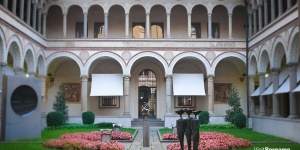
Sometimes the most hidden treasures are also the most beautiful ones. Take the Santa Marta Cloister, for instance.
Even though it is not visible from the outside, this cloister hosts two invaluable sculptures: a statue – “The Sitting Cardinal” – made by the Bergamo sculptor Giacomo Manzù, and a monolith created by the renowned artist Anish Kapoor.
It is a very evocative place, indeed, thanks to its beautiful columns and capitols creating a peaceful urban oasis. Despite its six hundred years, its charm didn’t change at all: walking along its arcades you will feel like you’re carried to another time.
This amazing hidden place used to be part of an old monastery (now disappeared) and can be reached by the Crispi Gallery, giving onto Piazza Vittorio Veneto.
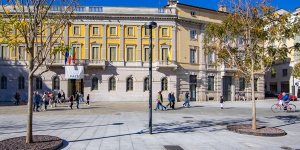
The Palace was named after the family who built it and lived there over more than 90 years, till Enrico Frizzoni decided to leave it to Bergamo, so that it could host the City Hall. Designed by Rodolfo Vatini, Palazzo Frizzoni was built between 1836 and 1840 in a beautiful neoclassical style: the twelve Corinthian pilasters separating the façade’s windows remind of the Roman architecture, as well as the arcade with the eight Ionian columns you will find inside.
During the institutional celebrations, you can also visit the interiors of the Palace! On top of the staircase there is the Hall used for the municipal council meetings. On the other side, if you enter the Mirrors Hall you can admire the wonderful mosaic floor featuring the Frizzoni emblem, consisting of two arrows bound by a ribbon. On the ground floor, go visit the Galleria dei Cardinali: you will find the portraits of Bergamo’s cardinals, including Angelo Roncalli’s, who became Pope John XXIII. Palazzo Frizzoni is also a picture gallery: in fact, it hosts 80 paintings coming from the Accademia Carrara.
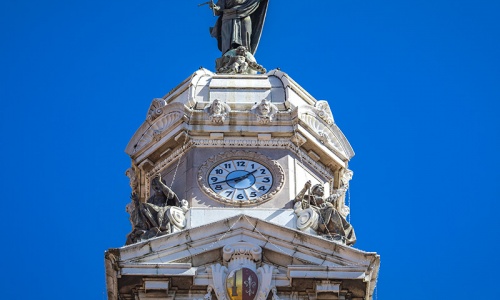
After Palazzo Frizzoni, turn right and walk along Via Borfuro. This street, today largely modern thanks to shops and renovations, also has a long history, partly linked to that Waldensian community which here, at no. 14, celebrated its cult inside the house of the Maritons, relatives of the Blondels to whom Manzoni would be linked by marrying Enrichetta.
The road meets in the middle of Via S. Alessandro, another historic street in the centre. If you turn right you can make a short detour and see not only the Renaissance convent of S. Benedetto, still today the seat of a religious community, but also the former Church of S. Maria Maddalena, where exhibitions and cultural events are often held.
POI
After Palazzo Frizzoni, turn right and walk along Via Borfuro. This street, today largely modern thanks to shops and renovations, also has a long history, partly linked to that Waldensian community which here, at no. 14, celebrated its cult inside the house of the Maritons, relatives of the Blondels to whom Manzoni would be linked by marrying Enrichetta.
The road meets in the middle of Via S. Alessandro, another historic street in the centre. If you turn right you can make a short detour and see not only the Renaissance convent of S. Benedetto, still today the seat of a religious community, but also the former Church of S. Maria Maddalena, where exhibitions and cultural events are often held.
POI
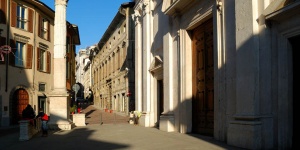
Tradition has it that Sant’Alessandro, Bergamo’s patron saint, was beheaded in the exact place where the imposing column stands. The monument was put back together in 1618 using stone fragments of Roman buildings and represents the only remain of the cathedral dedicated to the Saint in the IV Century, later destroyed.
The current church (featuring the column on the churchyard) dates back to 1447, but was only completed in the early XVIII Century. The tower bell, instead, was finished in the XX Century.
On the inside there is one single nave with four chapels on each side: if you’re not superstitious, go visit the chapel dedicated to the “Patrocinio” Blessed Virgin, built over the old cemetery.
Besides, numerous works of art are guarded inside the chapels and the sacristies, including the wonderful painting by Lorenzo Lotto “Dead Christ Mourned”, a rare example of tempera on canvas (1520-1521).
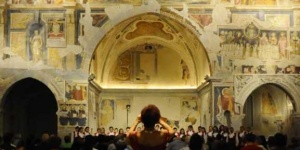
Merciful glances used to welcome those who were housed inside the hospital next to the Church of Santa Maria Maddalena: you will find them in the angels sustaining the architrave and in the Mary Magdalene, portrayed inside the lunette.
The religious complex dates back to the XIV Century, when the school of the “White Disciplini” (lay people gathered in congregations and brotherhoods who used to live a life of prayer and penance) built the church and the adjacent hospital aiming to host people in need, who used to be really numerous during that time.
This institution lasted almost five centuries, undergoing several changes: nevertheless, the church and the pointed arch portal remained the same, overlooking a small yard accessible from via Sant’Alessandro.
During the XVIII Century, a colonnaded cloister was built: the overall effect is quite peculiar, because frames, balustrades and capitals are the typical elements of Renaissance style, and not the Baroque one (characteristic of that time).
The church, protected by the Department of Architectural Heritage, is currently deconsecrated and it is used to host exhibits and conferences.
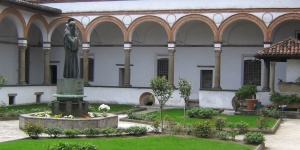
The San Benedetto Monastery complex, which includes the monastery and the church, is located just below the Venetian walls, in what was once the Santo Stefano borough, is today Via S. Alessandro.
Santa Maria Novella, originally a Humiliati foundation, passed in the 14th century to the Benedictines of S. Giuliano di Bonate. The Benedictine nuns of Valmarina (there are known records of them from 1153) moved from the countryside the following century, settling just below, always along Via S. Alessandro (the Rizolo). It is known that a small church was erected in 1448, dedicated three years later to St. Benedict; architectural traces of it remain on the side of Via S. Alessandro.
After 1493 the two communities united and the new settlement grew rapidly. In 1504 construction of the new church began; already by 1516 it appeared that restoration was necessary, due to the collapsing of a wall. The new project was entrusted to the Bergamo architect Pietro Cleri known as Isabello, who had already been responsible for the rearrangement of the nuns' inner chapel, frescoed in the years 1510-15 by Jacopino de' Scipioni and workshop, later transformed into the major sacristy.
During the 18th century the church experienced further changes but, with the advent of the Cisalpine Republic in 1797 and the suppression of religious orders, the monastery was suddenly closed and its liturgical furnishings-including a silver altar, vestments and numerous furnishings-were requisitioned by the Napoleonic authority. The altarpieces suffered the same fate, in fact both Gianbattista Moroni's Assunta and Calisto Piazza's S. Stefano were transferred to the Brera Museum.
Despite the situation, the nuns were able to remain living in the monastery, albeit with a very limited community life. The monastery became one again, in name and in fact, with its restoration on May 10, 1827.
In much more recent times, the monastery has once again unveiled details of its history thanks to some work inside the sacristy-with the discovery of the fragment of a fresco of the miraculous Madonna del Pianto (Our Lady of Wailing), which made it possible to identify the ancient site of the oriented presbytery-and the flooring, carried out in the 1980s.
San Benedetto cloister
Along Via S. Alessandro opens the porticoed cloister of San Benedetto, which presents itself as an elegant entrance to the Monastery. Made by Pietro Isabello, it has a rectangular plan on six round arches, supported on three sides by sandstone columns. In the twelve lunettes, many sixteenth-century frescoes by Cristoforo Baschenis 'the Young' stand out, retracing the life of San Benedetto.
The cloister constitutes the passage between the exterior of the structure and the large monastic complex, which also has direct access to the church.
The church
The church still retains its sixteenth-century character and has a main facade and a side tripartite by pilasters; in the centre of the main façade stands an architraved portal, surmounted by a small tympanum. The building has a central plan and a dome enclosed in an octagonal lantern.
The chancel, enclosed by a wooden transenna and placed above the elegant portico, allowed celebrations to be followed at the new north-facing altar from the Isabello.
Several noteworthy works of art are preserved inside, such as a Madonna con Bambino e santi (Madonna with Child and Saints) of Lottesque influence, executed by Lucano da Imola, and the altarpiece with Il Miracolo dell’acqua che sgorga dall’arca dei santi Fermo, Rustico and Procolo (The Miracle of the Water Gushing from the Ark of Saints Fermo, Rustico and Procolo by G. P. Cavagna (1621).
The valuable wrought-iron gate is from the 17th century. Capturing one's attention is the carved and gilded wooden Communicatoio by the Ticinese Carabelli. Then all that remains is to look up and admire the dome frescoed by G. A. Orelli in 1756, which presents the scene of the Coronation of the Vergine Maria tra I santi Benedetto e Scolastica (Virgin Mary between Saints Benedict and Scholastica), and the Titulars of the various Communities that gradually joined the primitive monastic nucleus over the centuries.
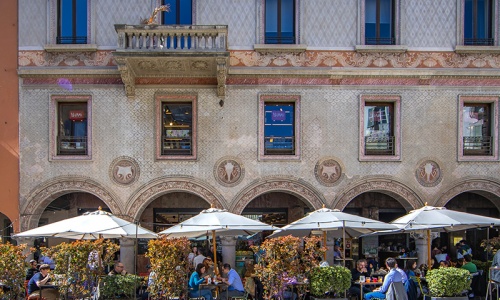
The lower section of Via S. Alessandro awaits you for the last stretch of the itinerary, full of vivacity among historic arcades, shops, restaurants and cafés. Reach Largo Rezzara, continue straight up to the beautiful Piazza Pontida and reach Largo Cinque Vie. You are in the heart of the San Leonardo Neighbourhood, the star-shaped neighbourhood which for centuries, thanks to its artisan and commercial vocation, has animated Bergamo with its liveliness. Music, parties and festivals such as Busker Night are just some of its attractions! A curiosity? The famous "Duchy of Piazza Pontida" is also located here, a long-standing goliardic association that keeps the city's culture, art and folklore alive.
To close the itinerary loop, after having explored at your leisure, leave Largo Cinque Vie and take Via Zambonate up to the first crossroads; turn right onto Via Quarenghi and immediately onto Via Spaventa to discover other local shops and businesses.
Once back on Via Zambonate, you will soon reach Via Tiraboschi and Porta Nuova, from which to embark on new adventures!
POI
The lower section of Via S. Alessandro awaits you for the last stretch of the itinerary, full of vivacity among historic arcades, shops, restaurants and cafés. Reach Largo Rezzara, continue straight up to the beautiful Piazza Pontida and reach Largo Cinque Vie. You are in the heart of the San Leonardo Neighbourhood, the star-shaped neighbourhood which for centuries, thanks to its artisan and commercial vocation, has animated Bergamo with its liveliness. Music, parties and festivals such as Busker Night are just some of its attractions! A curiosity? The famous "Duchy of Piazza Pontida" is also located here, a long-standing goliardic association that keeps the city's culture, art and folklore alive.
To close the itinerary loop, after having explored at your leisure, leave Largo Cinque Vie and take Via Zambonate up to the first crossroads; turn right onto Via Quarenghi and immediately onto Via Spaventa to discover other local shops and businesses.
Once back on Via Zambonate, you will soon reach Via Tiraboschi and Porta Nuova, from which to embark on new adventures!
POI
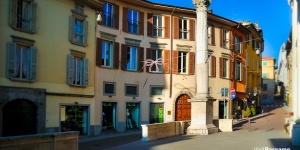
Borgo San Leonardo is an historic junction in Lower Bergamo.
As soon as you arrive, you can immediately perceive its peculiar layout, where 5 roads come together in one square. If this place used to be an important business area, today Piazza Pontida is the centre of this lovely district, the ideal place to enjoy a fantastic aperitif surrounded by the beautiful setting created by the colourful ancient buildings: you can end your day by tasting the exquisite dishes of the many restaurants dotting the borough!
Strolling by the streets, it’s easy to notice the old artisan soul of this district, whose small shops and arcades create a peculiar mark in the urban landscape: today, they are just perfect to host the numerous events animating Borgo San Leonardo.
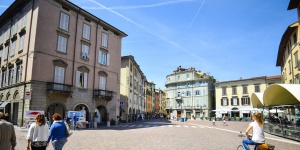
Piazza Pontida is the hub of the San Leonardo neighbourhood, where five streets converge.
For several centuries, this space represented the main commercial area of Bergamo: it was in fact also known as "Piazza della Legna", legna meaning wood, precisely because it was the main place of exchange of this precious material, mostly coming from the Brembana Valley. Over time, the numerous shops were then joined by trattorias and cafés, which occupied many of the existing premises especially between the nineteenth and twentieth centuries.
Today the square is the perfect place to enjoy a fantastic aperitif, surrounded by a picturesque and characteristic setting of coloured buildings, on whose facades time is rendered poetry. The day can end in the best possible way by trying the cuisine of the many restaurants in the area!
Another curiosity? From its porticoes, the famous Duchy of Piazza Pontida watches over the city, the ancient goliardic association that preserves the traditions, art and folklore of the city of Bergamo. The Duchy is also the organiser of the unmissable mid-Lent parade that takes place every year, to be joyfully celebrated amid costumed groups and competitions for the election of the "most beautiful old woman".
The Smiciatöt, the Duke of Piazza Pontida, always opens the parade!